
Introduction
On our test bench, today is the first add-in-board partner-designed custom AMD Radeon RX 7900 XT GPU-based video card we have tested. The XFX SPEEDSTER MERC 310 AMD Radeon RX 7900 XT BLACK Edition is a new, completely custom video card, from XFX sporting the new Radeon RX 7900 XT GPU. This is the RX-79TMERCB9 model, which is a factory-overclocked “Black Edition” video card from XFX with custom cooling and design. The full product description for this video card is XFX SPEEDSTER MERC 310 AMD Radeon RX 7900 XT BLACK
Gaming Graphics Card with 20GB GDDR6, AMD RDNA 3.


Released in December 2022, the AMD Radeon RX 7900 XT video card was launched. The Radeon RX 7900 XT introduces AMD’s new chiplet technology for GPUs and the RDNA 3 architecture. This is our first look at a custom video card, so we are interested to see how it performs, and what overclocking looks like with it and power draw. We will be testing at 4K with and without Ray Tracing, and FSR, as well as 1440p with Ray Tracing.
XFX SPEEDSTER MERC 310 AMD Radeon RX 7900 XT Black Edition
The XFX SPEEDSTER MERC 310 AMD Radeon RX 7900 XT Black Edition represents a unique design and is the top-of-the-line SKU from XFX for the Radeon RX 7900 XT offerings. XFX features two different lines of SKUs for the Radeon RX 7900 XT. The SPEEDSTER MERC 310 Black Edition, a SPEEDSTER MERC 310 non-Black Edition, and the RX 7900 XT Gaming Graphics Cards. The Gaming Graphics is XFX’s AMD reference design, while the SPEEDSTER MERC 310’s are the custom design. The difference between the Black Edition and non-Black is the factory boost clock. The Black Edition is clocked at a 2560MHz boost clock and the non-Black Edition is clocked at a 2535MHz boost clock. As a reminder, the reference AMD boost clock is 2400MHz on the made-by-AMD cards.
Therefore, the model we are testing, the Black Edition, has a high factory overclock at 2560MHz out-of-the-box. The reference (MBA, “made by AMD”) AMD Radeon RX 7900 XT is set to retail for an MSRP of $899. The XFX SPEEDSTER MERC 310 AMD Radeon RX 7900 XT Black Edition is currently priced at $879 from Newegg and $899 at Amazon. This video card comes with a 3-year warranty.
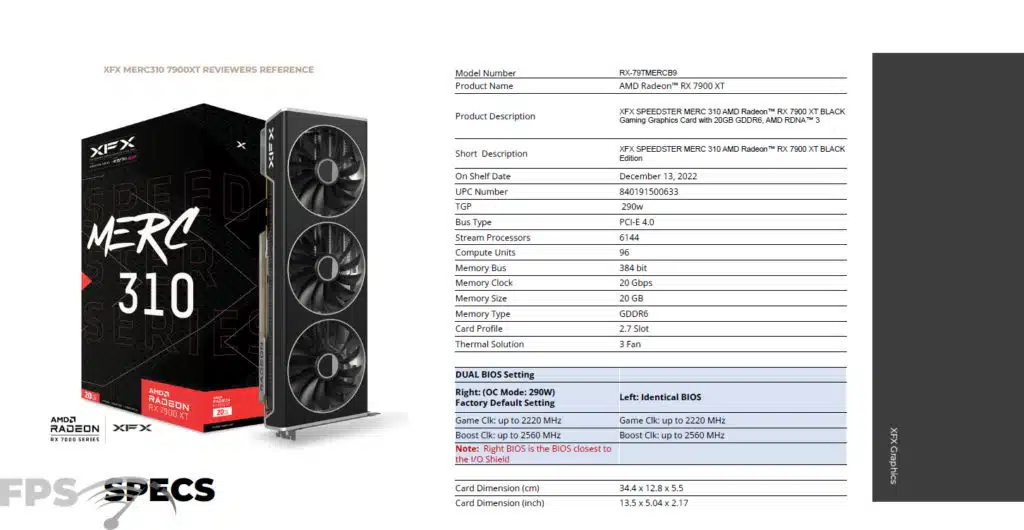
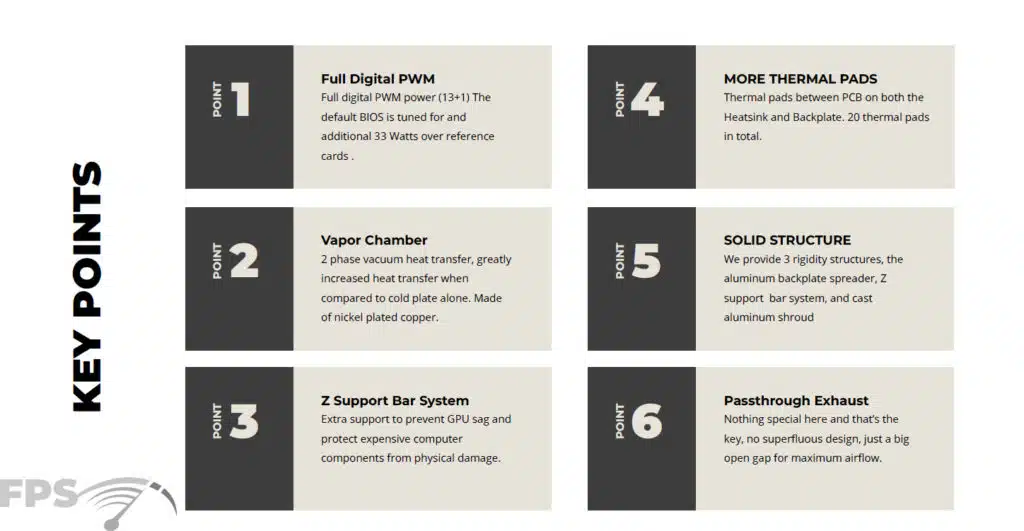

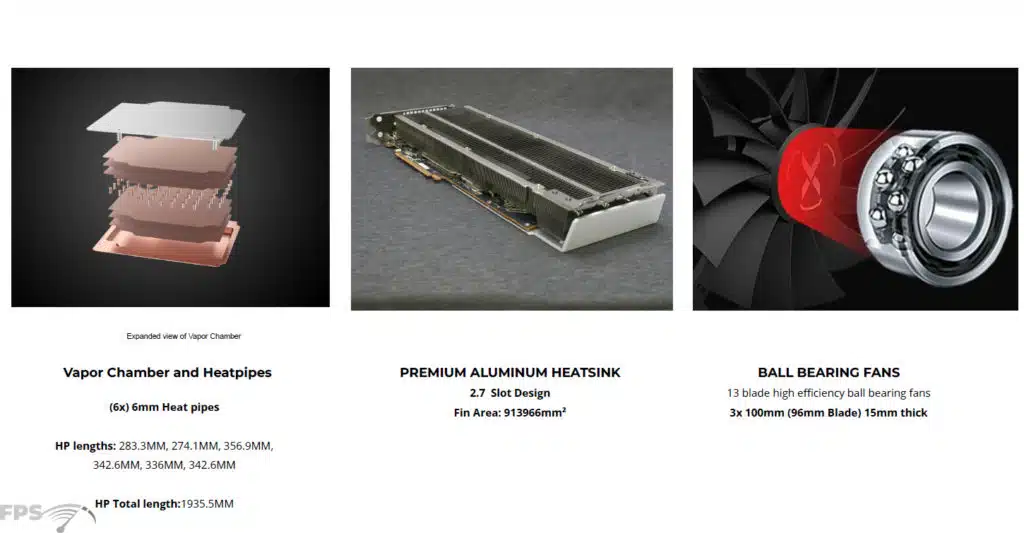

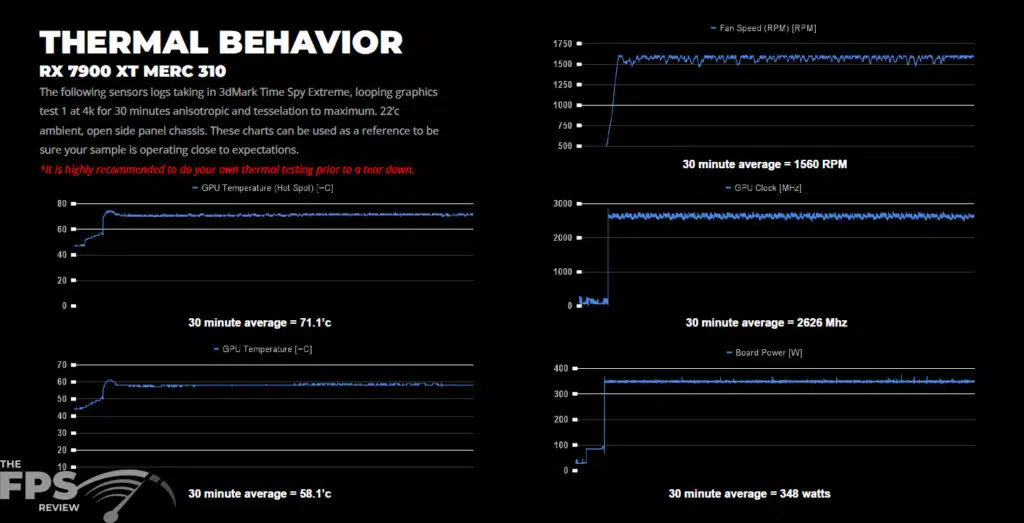
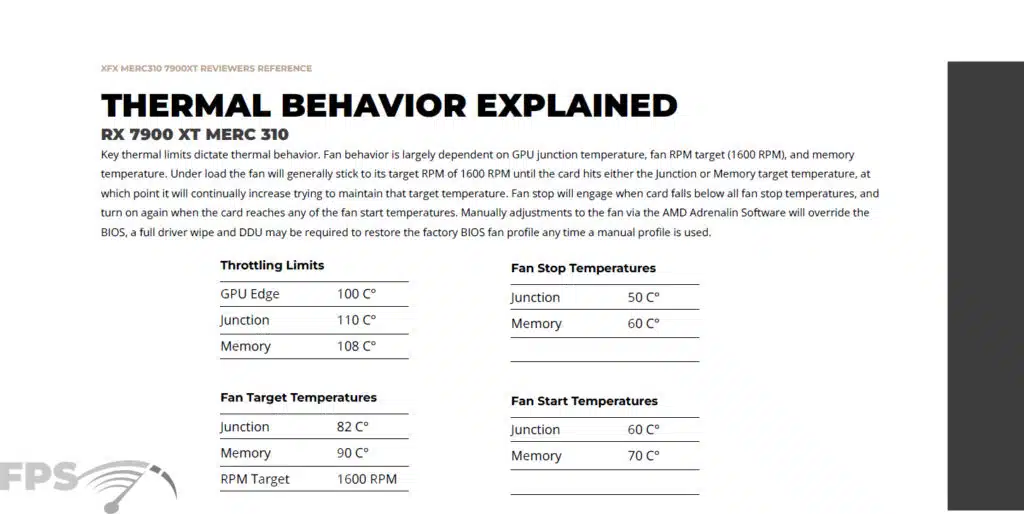
Above, we have some of the important press information regarding the XFX SPEEDSTER MERC 310 Radeon RX 7900 XT Black Edition video card, as this video card is built with interesting features. It has a fully digital PWM with a 13+1 phase design, and the default bios is tuned for an additional 33W over reference cards. It also uses a 2-phase vacuum heat transfer vapor chamber made of nickel-plated copper covering GPU and memory. It has 6x 6mm heat pipes. It has a 2.7-slot design aluminum heatsink. The fans are 13-blade ball-bearing fans, 3x 100mm fans. It also has a total of 20 thermal pads, covering GPU, memory, VRMs, and even the backside of each to make contact with the backplate using it as passive cooling as a backplate heat spreader with more surface area than the last gen.
XFX has provided power, thermal, and fan readings testing in-house. We can see here that with 30 minutes of testing the Hot Spot temp is only 71.1c, GPU Temp is 58.1c, all while boosting to 2626MHz at 1560 RPM fan speed and 348W of power. We will test this on our own of course, but up front, these are impressive numbers. This would be cooler, and with a higher frequency than we experienced on our MBA Radeon RX 7900 XT.
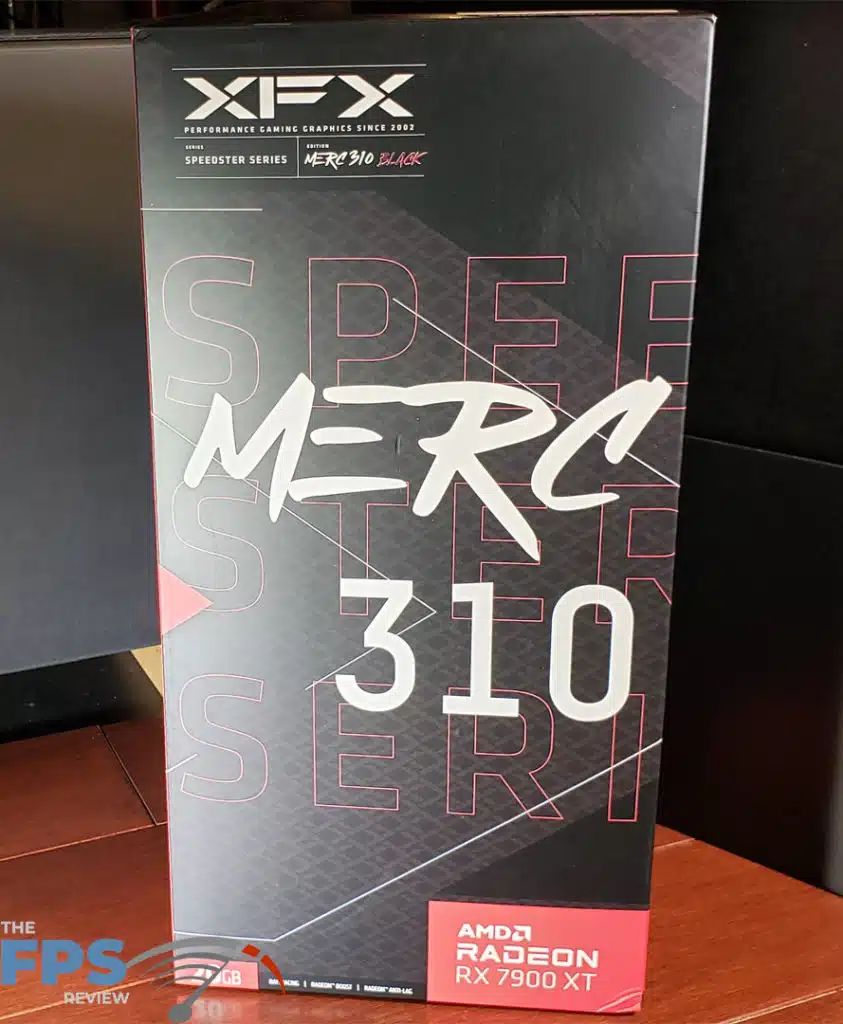
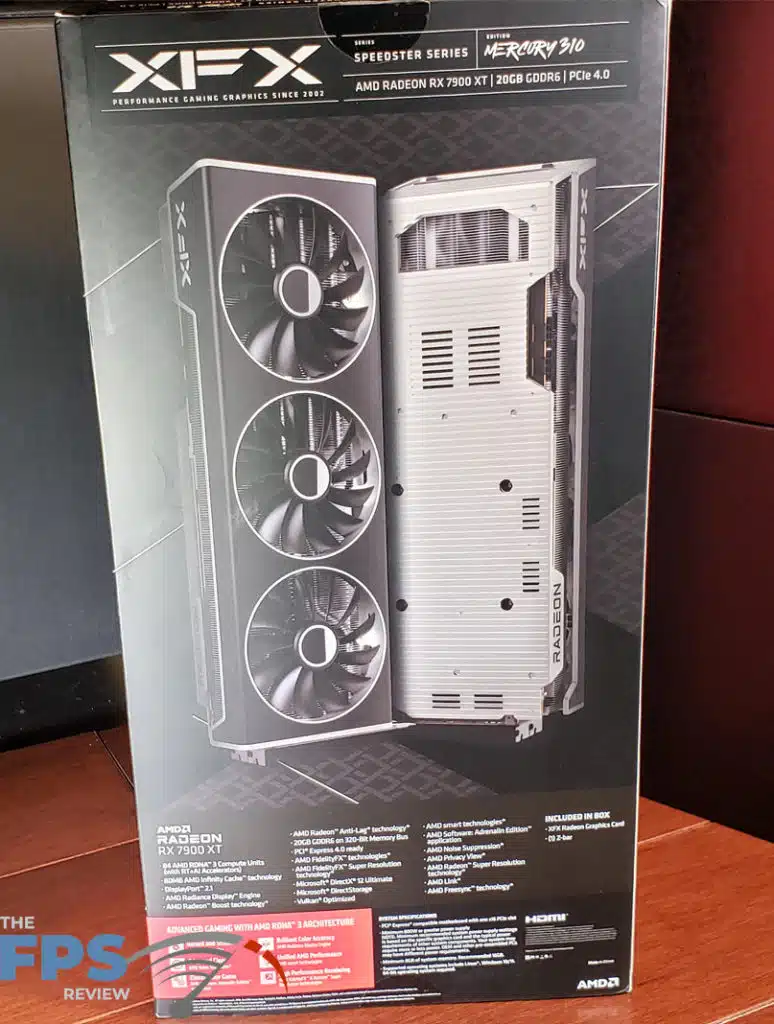
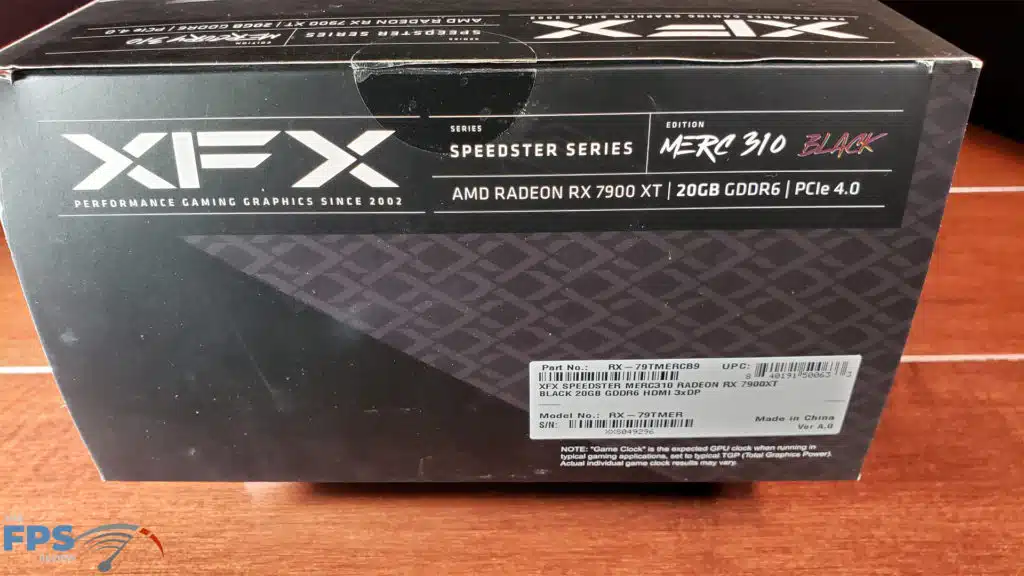
The card is full die-cast aluminum front and back, the full coverage backplate is vented and extra thermal pads have been added, cooling is from three large ball-bearing fans directly onto a large full-length heatsink that features vapor chamber technology. The front and rear of the card are vented. XFX SPEEDSTER MERC 310 design is a modern, minimalist approach, with the primary purpose focused on cooling based on XFX GHOST THERMAL design. There is no RGB, but rather a simple lighted “XFX” on the far front and a striking black and silver color scheme. The very stylish top shroud is one piece and exclusive to the Black Edition.
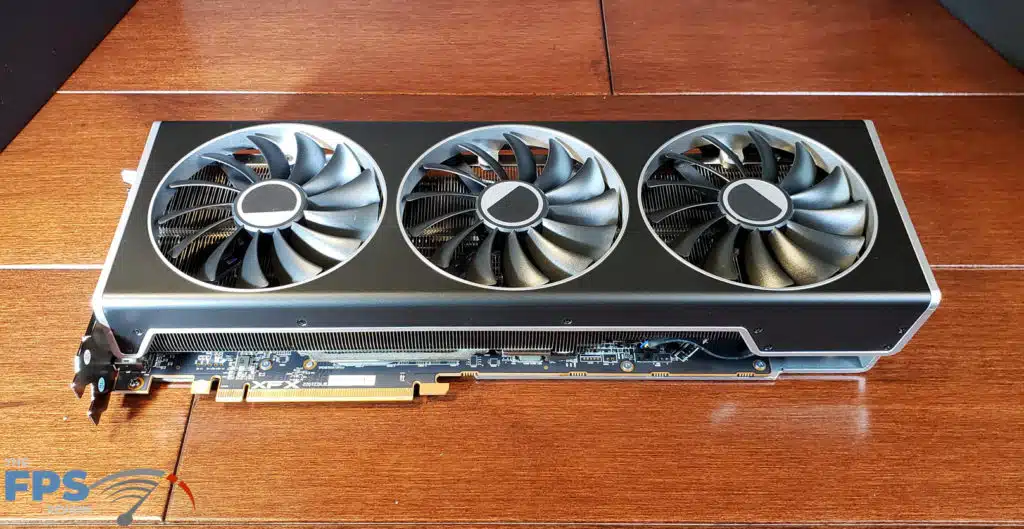

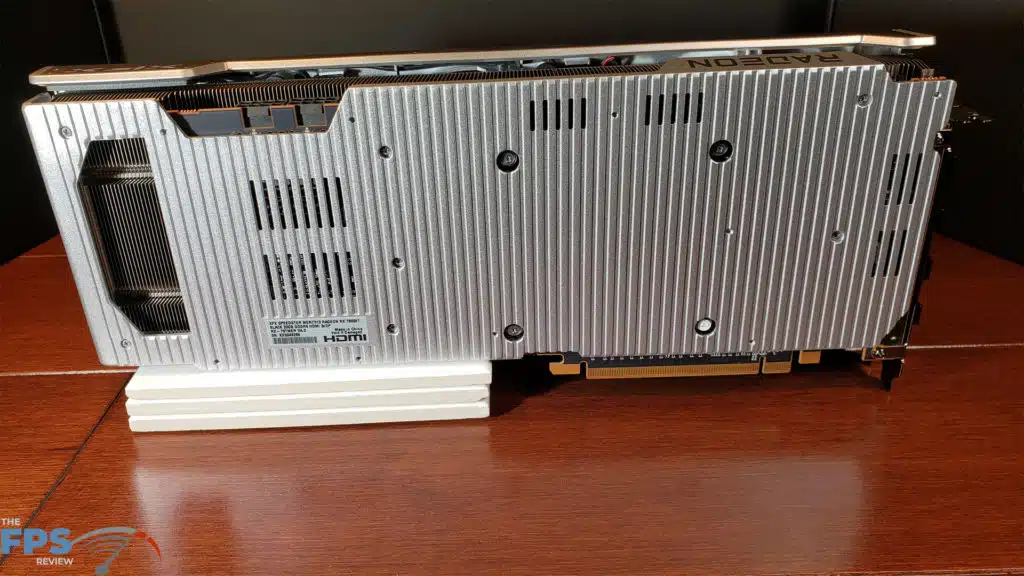
This video card looks and feels well-constructed. The backplate is curved up from the bottom to cover the rear venting. The entire shroud is die-cast aluminum and is 3mm thick, there is a distinct NFL Raiders look to this card, due to the silver and black motifs, which is very sharp and understated. The three fans measure 100mm. The backplate and cooling have been improved to include heatpipe technology, “zipper” radiator orientation, and additional thermal pads, as noted in the press release.
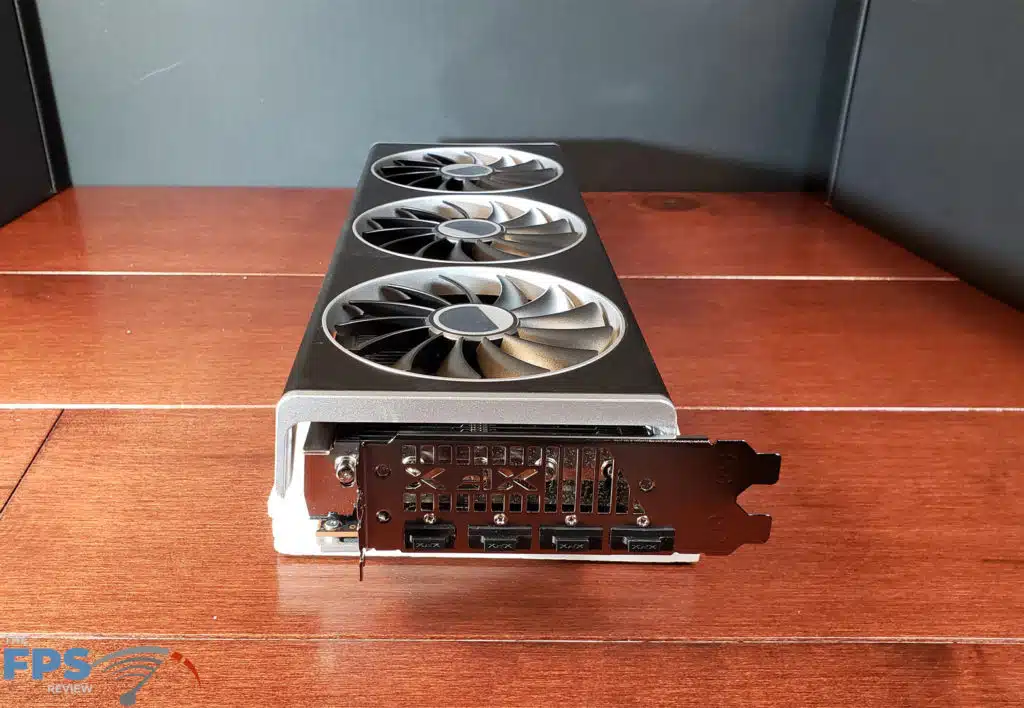
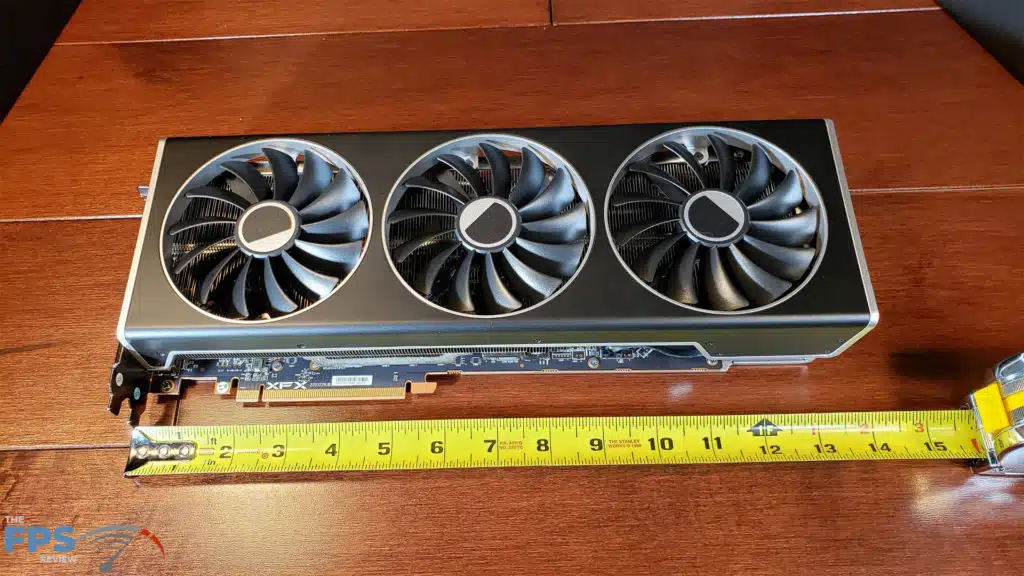

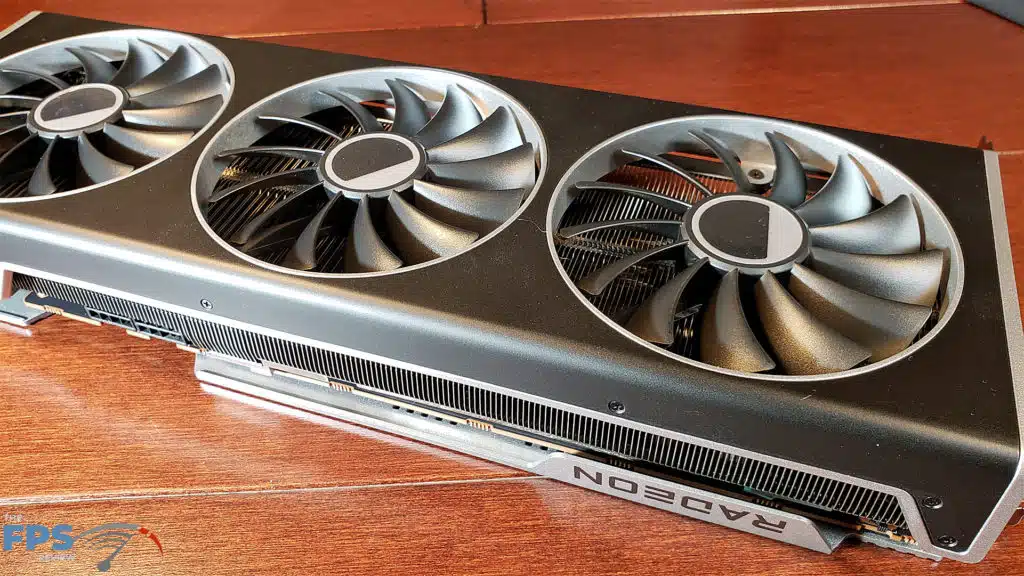

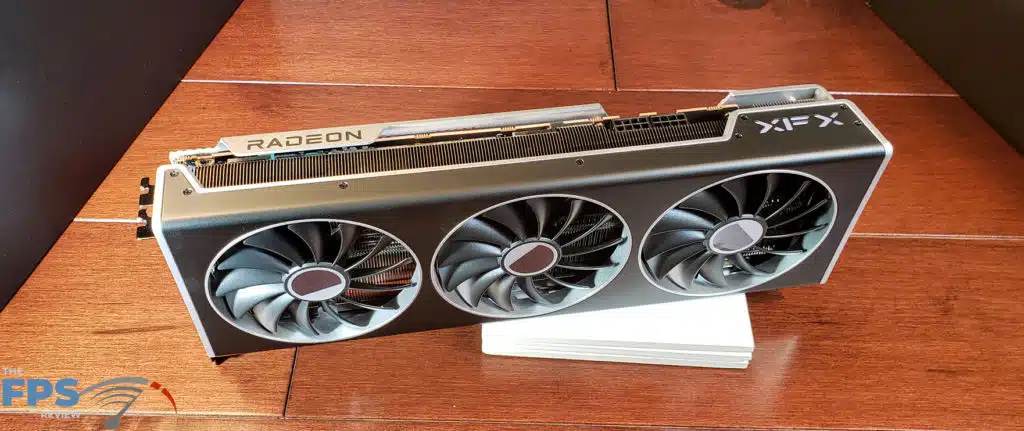
Our card also features a dual BIOS switch located near the front of the card. This apparently has some effect on power to the board, more in the conclusion. Overall the card measures 13.5 x 5.04 x 2.17 inches. The weight is 3lbs 15oz. This is a 2.7-slot card. The I/O supports two DisplayPort 2.1, one DisplayPort 1.4, and one HDMI 2.1.
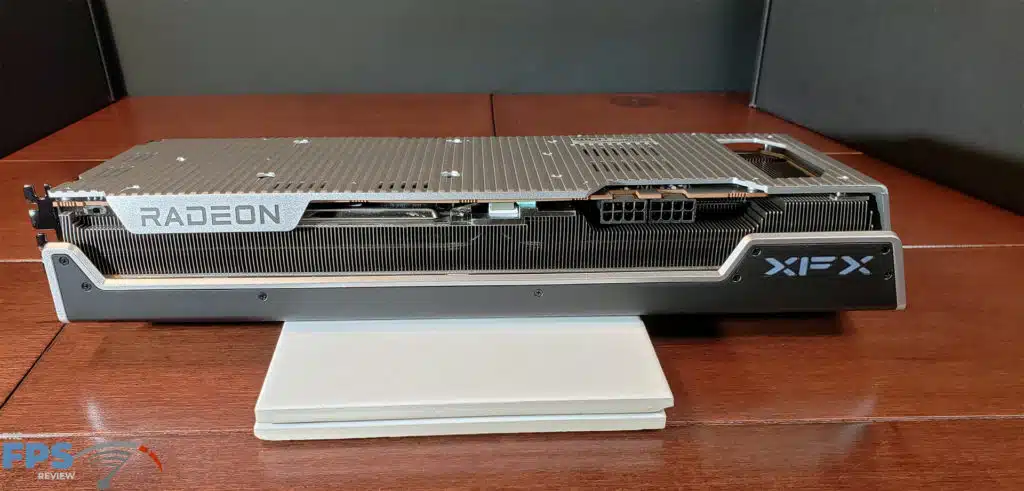

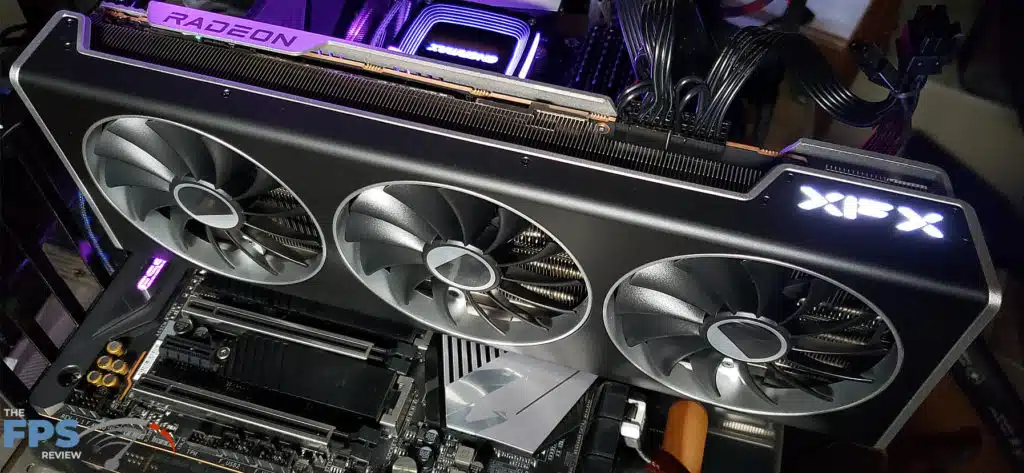

Power is supplied via two PCIe 8-pin connectors. XFX recommends a minimum of 750W PSU. The video card has a top-rated Board Power of 315W. Also included in the box is what XFX calls their Z Support Bar. This is a thick metal bar that mounts to the rear of the video card and the rear I/O housing of your case to support the weight of the card, in lieu of the small support stands one has seen lately. It is a very stout solution.
Test Setup
More information on our GPU testing can be found here. We are using the motherboard’s current default BIOS settings on the latest official release BIOS. We have enabled PCI-Express Resizable BAR in the motherboard BIOS. This means we are utilizing Resizable BAR on NVIDIA GPUs and AMD Smart Access Memory on AMD GPUs in all of our testing. We have enabled DOCP in the BIOS for the memory.
We are using a fresh install of Windows 11 Pro with the latest Windows Updates, and drivers installed including the latest chipset drivers from AMD. We are using the “Best Performance” power profile in Windows Settings. We have Hardware Accelerated GPU Scheduling at the default setting, which is ENABLED. VBS is DISABLED and Game Mode is ENABLED.
*NOTE – The performance in the graphs for the ASUS TUF Gaming GeForce RTX 4070 Ti 12GB OC Edition Video Card is copied from that review. The GeForce RTX 4070 Ti is the price competitor with the Radeon RX 7900 XT, and thus the best competitor video card. The exact same software (games and Windows) configuration was used between both reviews, and the platforms are comparable for gaming performance which are GPU bound, not CPU bound in our game settings.
Overclocking the XFX SPEEDSTER MERC 310 AMD Radeon RX 7900 XT Black Edition
Prior to overclocking, we will determine the base GPU clock speed. Both NVIDIA and AMD have dynamic base speeds, both have a “Boost” speed. (GPU Boost or Boost Clock, depending on the brand.) Generally, either brand’s card will exceed the “Boost” dynamically. To determine the “baseline” we record the GPU frequency in our Cyberpunk 2077 manual run-through. This is a lengthy manual run at Ultra settings. Data is captured for frequency, temperature, voltage, and power using a GPU-Z sensor to log the data.
Default Frequency
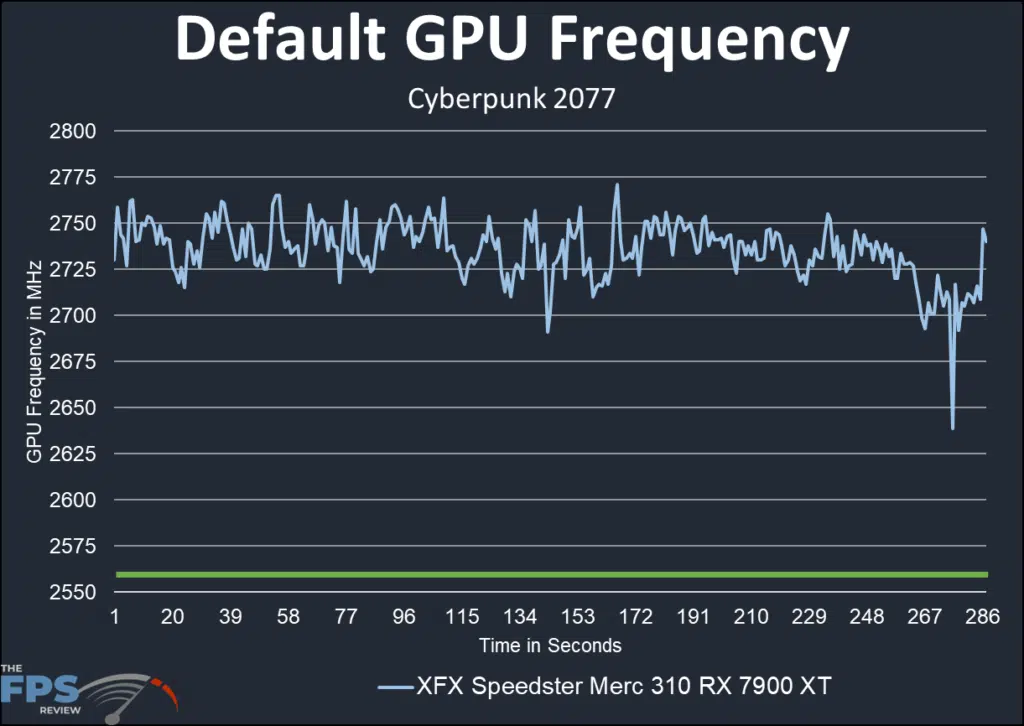
The default frequency for the reference AMD 7900 XT is listed as a base (Game Clock) of 2000MHz and a Boost Clock of 2400MHz. The XFX SPEEDSTER MERC 310 AMD Radeon RX 7900 XT Black Edition lists a Game Clock of 2220MHz and a Boost Clock of 2560MHz.
You can see from the above graph that our card runs well above the listed frequencies. On average our XFX SPEEDSTER MERC 310 Radeon RX 7900 XT Black Edition is running a default Boost of 2735MHz average. This is 175MHz above the quoted boost frequency for this video card, which is listed for our card which is 7% faster than the rated boost speed. This should give our card a nice kick, just at default performance. This is also higher than the MBA Radeon RX 7900 XT ran at default and 100MHz over the published press release clocks.
Overclocked Frequency
To overclock our card we use the software included in the AMD Adrenalin software. Under “Tuning” are selections for manual overclocking, automatic overclocking, power slider, GPU and memory frequencies, and fan controls.
Above is a screen capture of the maximum settings used. We did not overclock the memory, and the reason why is posted below, nor did we adjust the GPU core voltage as it did not help. According to XFX, the BIOS switch should be set closest to the I/O of the video card for “performance”. This is also the default setting from the factory.
The AMD software in this case requires a lot of trial and error. The GPU frequency slider is not precise, but rather offers a “maximum” which practically is not achieved. We ran some additional testing here to determine if there was any gain to just adjusting power by itself instead of GPU frequency. Frame rate values were identical in Default AND Maximum Power Slider run-throughs, but there was a small frequency change. Only when the GPU frequency was increased in conjunction with power, was there an increase in frame rates. We did not adjust the memory frequencies at all. There was a negative effect on the performance of the video card at minimal memory overclocks. This could be a bug with early drivers, though we are using the latest release drivers at this time.
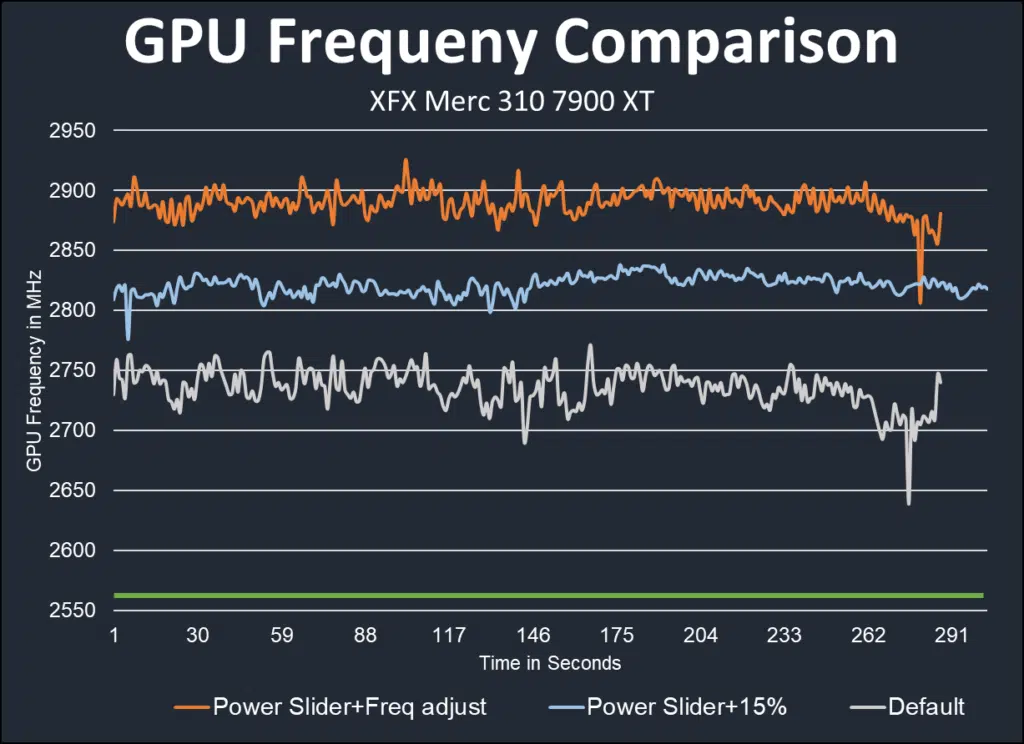
In the chart above, you can clearly distinguish the three different frequencies we encountered in this phase of the testing. The white line is our default frequency as above. The average is 2735MHz. The blue line is the findings when the power slider is set at maximum with otherwise default frequencies. This averages about 2825MHz. The orange line is our final overclocked frequency, which is achieved by setting a “maximum” GPU frequency of 3350MHz in the AMD software. The steady-state there was an average of 2880MHz. You can clearly see each of the frequencies is well above the listed Boost Clock of 2560MHz. Our gain above baseline is 12%.
Gameplay Performance at 4K
We have selected a suite of games to test the XFX SPEEDSTER MERC 310 AMD Radeon RX 7900 XT Black Edition at 4K. All our selections were set at the maximum in-game graphic settings or custom combinations. We will run the video card with and without Ray Tracing enabled in-game. DLSS and/or FSR are utilized in games that support the technology. Our video card will be compared to the ASUS TUF GeForce RTX 4070 Ti O12G-GAMING which was just recently released and is being reviewed. The price of the RTX 4070 Ti places it in direct competition with the XFX MERC 310 RX 7900 XT Black Edition.
Call of Duty Modern Warfare II
Call of Duty Modern Warfare II was released on October 27, 2022, on the PC and uses the IW 9.0 gaming engine. The game supports all upscaling methods, including NVIDIA DLSS, NVIDIA Image Scaling, AMD FSR 1.0, AMD Fidelity FX CAS, and Intel XeSS. We use the highest quality option of each. We customize every graphics setting to the maximum value for the best image quality and enable everything. We use the built-in benchmark.
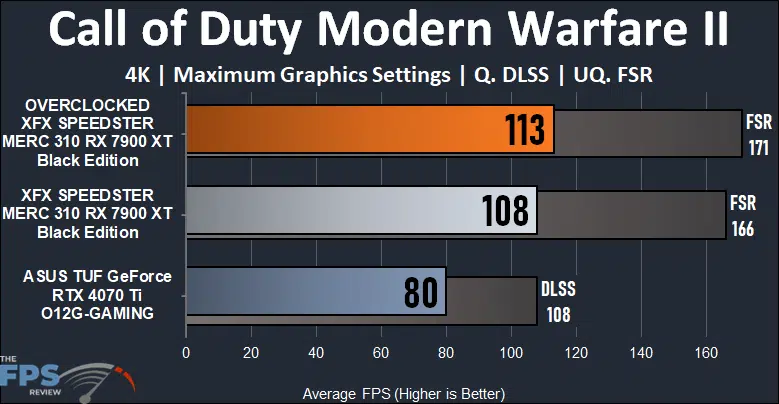
Coming right out of the blocks, our XFX Merc 310 RX 7900 XT Black shows it is quite fast. We see a 35% benefit over the ASUS TUF RTX 4070 Ti. The addition of FSR is even more impressive here, at a 58% improvement. Overclocking gains about 5%.
F1 2022
F1 2022 was released on June 28th, 2022 on the PC and uses Codemasters Ego engine. The game supports Ray Tracing, DLSS, AMD FidelityFX, and FSR. We ran the game with the highest quality settings of “Ultra High” and TAA+FidelityFX. DLSS and FSR were enabled as needed at the Quality setting for both. The built-in benchmark was used at the Imola track, in dry conditions with a far chasing cam.
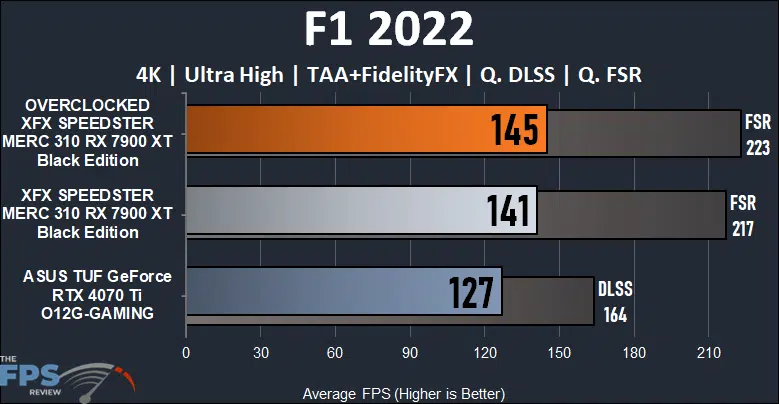
This game allows very high frames in plain raster performance. The XFX MERC 310 RX 7900 XT Black is 15% quicker than the ASUS TUF RTX 4070 Ti here. Overclocking adds an additional 3%. Obviously, the upscaling results are blistering. The FSR results show a 36% gain over the ASUS TUF RTX 4070 Ti
Dying Light 2
Dying Light 2 was released in February 2022 on the PC. It uses Techland’s C-Engine and supports Ray Tracing for various environmental effects including Ray Traced Soft Shadows, Ray Traced Ambient Occlusion, Ray Traced Global Illumination, and Ray Traced Reflections. It also supports both DLSS and FSR 2.0 upscaling technologies. For our benchmark, we are using a custom manual run-through.
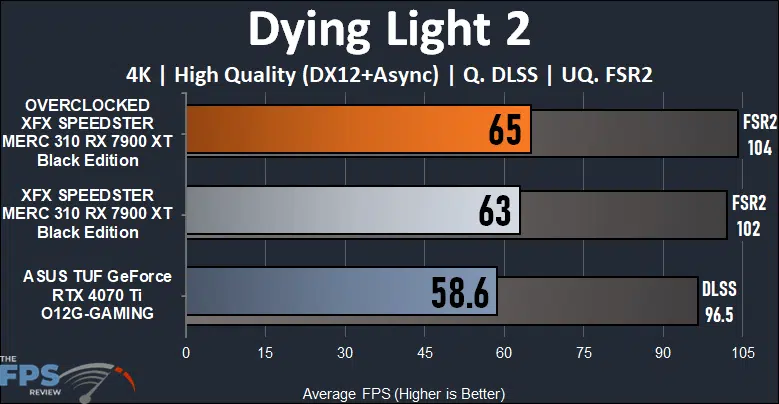
Dying Light 2 is very demanding, however, our XFX MERC 310 RX 7900 XT Black has a very playable frame rate without any help at 63 FPS. We see an 8% better framerate than the ASUS TUF RTX 4070 TI, which can’t quite get to a playable rate. When FSR is enabled the frame rates are nicely boosted across the board. The performance is very closely matched. Overclocking adds a 3% boost here.
FarCry 6
Far Cry 6 was released in October of 2021 and uses the Dunia Engine. We utilize the built-in benchmark for testing. We have the HD Texture pack installed and turned on. We utilize the “Ultra” graphics preset which sets all options to the highest game settings. We also test the game’s support of AMD FidelityFX Super Resolution 1.0 to improve performance on both GPUs

A graphically beautiful game with excellent frame rates. Once again the XFX MERC 310 7900 XT Black is out in front by 40%. Close to the same margin is held when FSR is enabled. The overclock adds 2.5% which is essentially unchanged. The basic frame rate is so fast here it hardly warrants upscaling.
Cyberpunk 2077
Cyberpunk 2077 was released in December 2020 and uses the REDengine 4. We have the game patched to version 1.61 for our testing and perform a long manual run-through driving in the game’s open world. We test using the Preset options for Ultra quality and for Ultra Ray Tracing. This game also supports DLSS and AMD FidelityFX Super Resolution FSR 2.1. We test DLSS Quality on NVIDIA GPUs and FSR 2.1 Ultra Quality on AMD GPUs. Testing on our AMD video card shows no frame rate advantage FSR 1.0 versus FSR 2.1.
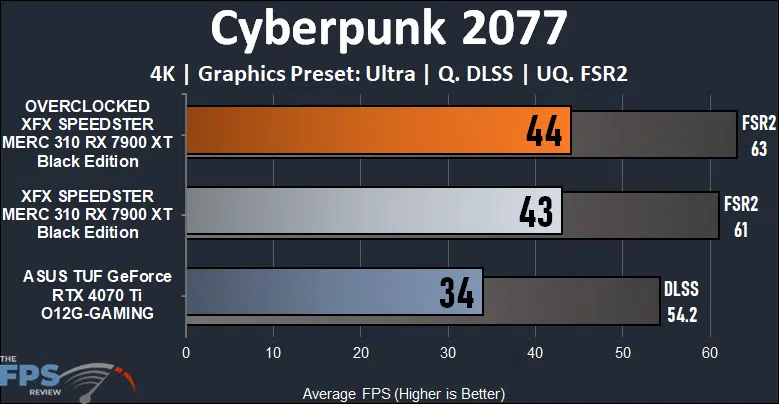
In another of our very demanding games, neither of the video cards was able to reach a playable rate without help. Nonetheless our XFX MERC 310 RX 7900 XT Black is 30% quicker than the ASUS TUF 4070 Ti. Upscaling adds 50% to the framerate of the XFX MERC 310 7900 XT. This allows a very playable game with the highest settings. The ASUS 4070 Ti struggles here even with upscaling. Overclocking is a 2% benefit.
Watch Dogs Legion
Watch Dogs Legion was released on the PC in October of 2020 and uses the Disrupt game engine. We utilize the built-in benchmark for testing. We have the HD Texture pack installed and enabled for testing. We use the built-in graphics preset of “Ultra” for testing. Only DLSS is available in this game as an upscaling option.
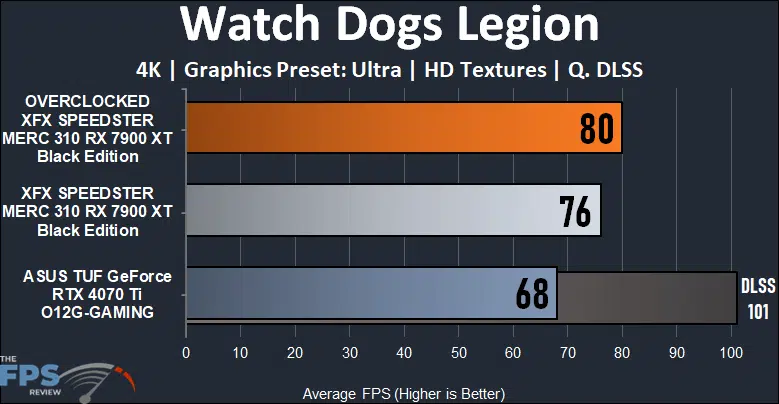
Another of our demanding games, this time both cards have playable rates right off the bat. The XFX MERC 310 7900 XT Black is 12% faster here. The overclocking adds 5%. Finally, the ASUS TUF 4070 Ti moves ahead with upscaling. The gain of 48% allows it to eclipse our card, but only because this game does not offer FSR. Oh well, a partial victory!
Gameplay Performance at 4K with Ray Tracing
For this section, we enable Ray Tracing in game. All the settings otherwise remain unchanged, 4K with all the dials turned up as high as they go. DLSS and FSR are once again utilized where it is suitable and supported by the game.
F1 2022

F1 becomes much more demanding with Ray Tracing enabled. Neither of the cards runs a playable frame rate without help. The game is not smooth without upscaling. The ASUS TUF 4070 Ti is faster, but it all depends on whether you enable upscaling. Without it, 10% faster. With upscaling the XFX MERC 310 7900 XT Black is 10% faster. Interesting.
Dying Light 2

Dying Light 2 flexes its muscles when Ray Tracing is enabled. Neither of the cards we used was playable. In this game, the ASUS TUF 4070 Ti is the better regardless of upscaling or not. The margin is 23% plain and 16% with upscaling enabled. Unfortunately even with upscaling, another card can reach 60FPS. Overclock boosted performance by 8%.
FarCry 6

FarCry 6 flips the tables. We can see the XFX MERC 310 7900 XT Black take the prize here by 28%, 19% with upscaling enabled. Overclocking adds 6%.
Cyberpunk 2077

Once again, Cyberpunk shows how demanding it is. Neither card can muster frame rates at these settings that allow a playable game, upscaled or not. Still in this game, the ASUS TUF RTX 4070 Ti shows it has more Ray Tracing muscle by 25%. When upscaling is enabled the margin is 22% over the XFX MERC 310 7900 XT Black. Overclocking, for what it’s worth gained 4%.
Watch Dogs Legion
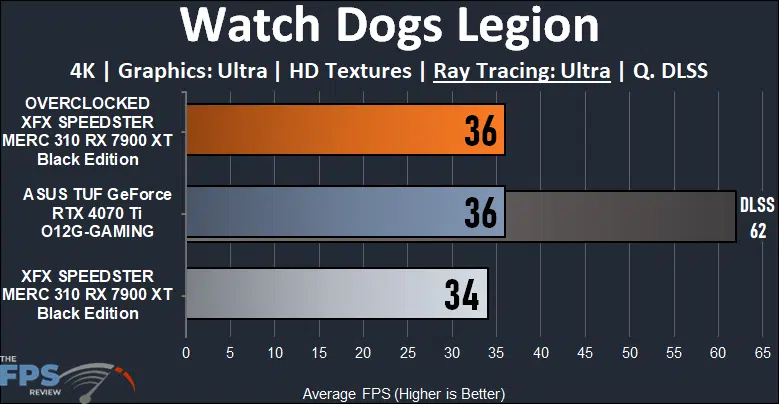
You can copy and paste the Cyberpunk discussion here, for the most part. Interestingly, we see a dead heat if you overclock. DLSS essentially slams the door on the competition. No FSR here. Overclocking boosts 5%.
Metro Exodus Enhanced
This game includes a very nice benchmark mode. It leans very heavily into Ray Tracing and is demanding. We run the benchmark on the “Extreme” settings and use “Ultra” Ray Tracing. DLSS is supported, Hairworks and Physx are also supported.

The ASUS TUF 4070 Ti takes the crown again in this game by a slim margin, and there is only DLSS. Unfortunately, the XFX MERC 310 7900 XT Black cannot muster a playable frame rate.
Gameplay Performance at 1440p with Ray Tracing
In this segment, we took four of the games in the suite that showed significant struggle for the XFX Speedster Merc 310 AMD RX 7900 XT Black in the Ray Traced settings at 4K and dialed down the resolution. This is meant to show what can be accomplished in gameplay if you wish to sacrifice just a little of the resolution quality, but still, gain all the maximum effects of Ray Tracing. The in-game settings otherwise were identical.
Dying Light 2
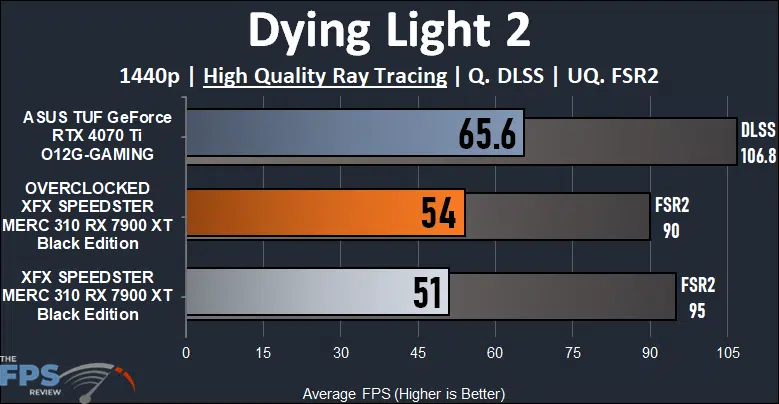
Moving down one notch to 1440 essentially doubles the frame rates for the XFX MERC 310 RX 7900 XT Black. Even without upscaling the game is close to playable. With FSR fast frame rates are noted, again almost double. The ASUS TUF 4070 Ti realized the same benefits and is playable without upscaling.
Cyberpunk 2077

As in Dying Light 2, moving down a notch doubles the non-upscale performance in this game. Although it’s still not good enough, we have a playable frame rate in Ray Tracing at Ultra settings at 1440p when FSR is enabled. The ASUS TUF 4070 Ti also shows a nice response. Upscaling in this game at this resolution is a real benefit.
Watch Dogs Legion
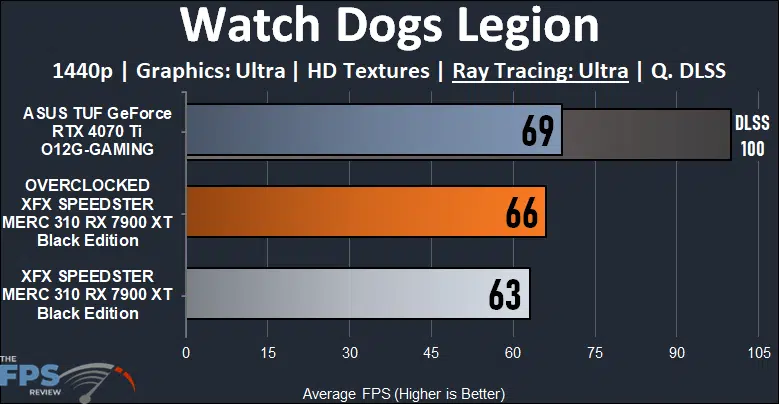
In Watch Dogs Legion each card is playable. The XFX MERC 310 RX 7900 XT Black gained over 45% at this resolution and nearly aces the ASUS TUF 4070 Ti until DLSS is enabled.
Metro Exodus Enhanced
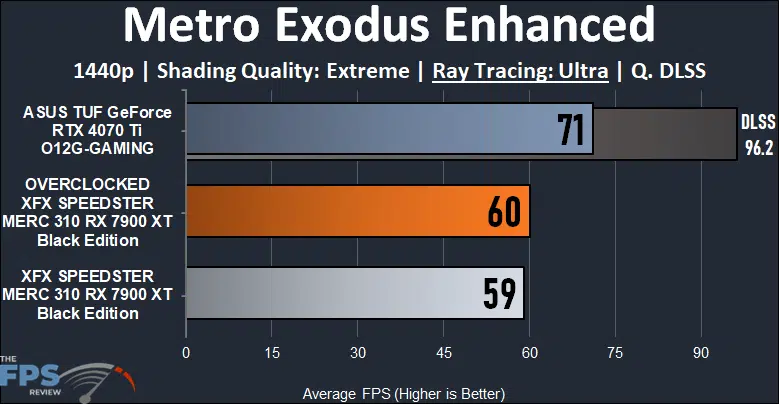
Our XFX RX 7900 XT is right at playable at this resolution. Sorry no FSR in this game either.
Power and Temperature
To test the power and temperature we perform a manual run-through in Cyberpunk 2077 at “Ultra” settings for real-world in-game data. We use GPU-Z sensor data to record the results. We report on the GPU-Z sensor data for “Board Power” and “GPU Chip Power” when available for our Wattage data. For temperature data, we report the GPU (Edge Temp of the GPU) as well as the Hot Spot (Junction Temperature) when available for our temperature data.
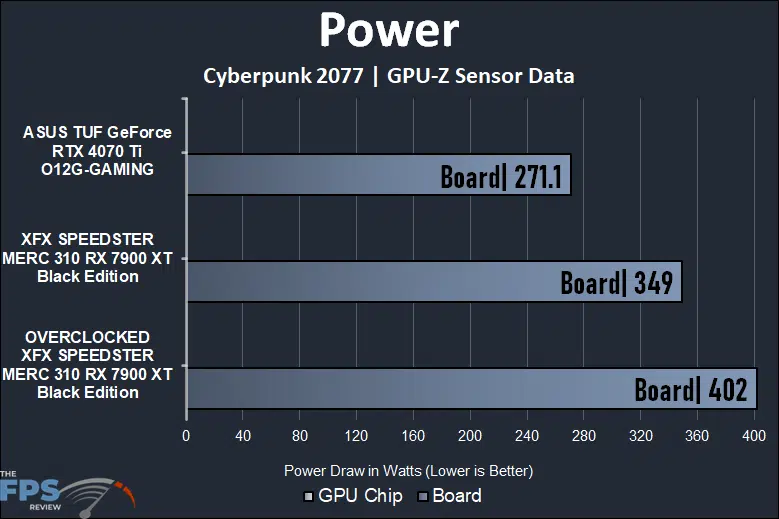
The power chart shows only the board power in GPU-Z due to a limitation with AMD video cards. Nonetheless, we can see the XFX Merc 310 RX 7900 XT Black draws more power than the ASUS TUF 4070 Ti by roughly 28%. When overclocked the XFX Speedster Merc 310 AMD RX 7900 XT draws in excess of 400 Watts. This power result matches the testing XFX also performed and resulted in.

The temperature chart shows that despite the higher power demand, the XFX MERC 310 RX 7900 XT Black has a very robust cooling system. Even overclocked the GPU and board are very cool. Of course, we have an aggressive fan profile during overclocked testing which explains and demonstrates the result.
The temperatures were quite low in both default and overclocked testing. In default testing, the fan curve was left on “auto”. When overclocking, a fan curve was used which quickly ramped up the fans to 100%. Unfortunately, the fans on our XFX Speedster Merc 310 RX 7900 XT Black are quite loud when set to 100%.


Conclusion
In this review, we had a chance to test our first add-in-board partner video card from the recent AMD release of its RDNA3-based NAVI 31. We looked at the XFX SPEEDSTER MERC 310 AMD Radeon RX 7900 XT BLACK Edition. The timing of the release of the NVIDIA GeForce RTX 4070 Ti allowed us to compare our video card against an ASUS TUF GeForce RTX 4070 Ti. We tested the cards at 4K with and without Ray Tracing and also sampled some 1440p gaming. We overclocked the XFX MERC 310 RX 7900 XT Black as well.
Performance
Performance testing shows that in rasterized gaming at 4K the XFX RX 7900 XT is very fast. In fact the XFX MERC 310 RX 7900 XT Black is on average 23% faster than the ASUS TUF 4070 Ti. Of course that 23% may not be enough in some of the more demanding games we use to test. Specifically Dying Light and Cyberpunk 2077, where neither of our cards could generate playable frame rates.
As with all the latest video cards, the true magic comes with upscaling, be it DLSS or FSR. When this function is enabled in the game it shows amazing returns. Even the most demanding games become more playable.
With Ray Tracing enabled our XFX MERC 310 RX 7900 XT Black shows its Achilles heel. At 4K and the settings we use to test cards, even the biggest and badest can stumble. Overall with Ray Tracing enabled, the XFX MERC 310 7900 XT Black trailed the ASUS TUF 4070 Ti. The interesting finding in this review was that the gap between the AMD and NVIDIA Ray Tracing performance is closing. The one exception was FarCry 6. But, to further rub salt into both cards’ wounds, no games were playable until upscaling was enabled and even then it was close in most.
The good news is the Ray Tracing performance of the XFX Speedster Merc 310 AMD Radeon RX 7900 XT Black when the resolution is set at 1440p. We tested our video cards against the most demanding games we use with everything set to the maximum. At this resolution, the XFX RX 7900 XT achieves playable frame rates in each game. In other words, if you are willing to dial down a notch, you can enjoy everything Ray Tracing has to offer at a nice smooth frame rate. Two games used FSR and two did not reach those values. That’s not to say the other video card didn’t improve too, but the goal with this portion of the testing was to evaluate smooth gameplay using the XFX MERC 310 RX 7900 XT Black.
Overclocking
Overclocking was a bit of a challenge. It seems enough has changed with this generation from AMD that a learning curve was inevitable. Apparently, there are two clock functions in RDNA3, the Front End and the Shader. Both clock up, but exactly which one is dominant and how that is determined is not perfectly clear. Next, when setting up the overclock, instead of having a well-specified endpoint, you are given a “maximum” clock; a range if you will. You have no idea where you will end up, or exactly how that range affects your adjustments. Next up is the power adjustment and how it may or may not affect the overclock.
First off, we used GPU-Z. This software only reports “GPU clock”. We can only assume this is the Front End clock on our XFX Speedster Merc 310 AMD Radeon RX 7900 XT. Second, the steady-state clock in our overclock trial was 2880MHz, a 12% increase from the factory clock, but a long way from the 3350MHz “maximum” set in the AMD software. Then there’s the power slider. You can see from the charting that pushing the power slider to +15% does in and of itself affect the GPU frequency, but that increase alone had no effect on the in-game frame rate.
So then, by old-fashioned trial and error, we arrived at our overclock of 2880MHz (by setting the GPU frequency “maximum” to 3350MHz and the power slider to maximum, a 12% increase over the factory. In the games, it is related to a 3 to 4% increase in the frame rate compared to the default settings. This minimal result may be part and parcel of the overclock already established in the factory BIOS. There simply may be no headroom to push the GPU further than we did. The fact is, XFX is already pushing the GPU as hard as possible with the factory overclock, and you are getting everything there is, by default, nothing is being left on the table.
The AMD software was reasonably straightforward to use. There are “automatic” overclocking functions too, but they seemed very conservative. The pathway to the overclocking portion is done by clicking on “Performance” at the top of the software home page.
Cooling on our XFX Speedster Merc 310 AMD RX 7900 XT Black was superb. The radiator runs the full length of the PCB and temperatures were never an issue. Below about 60% on the fan cycle there is minimal noise. However, if you push the fan cycle beyond that point, the noise is obvious. There is a noticeable rush from the fans and a background whine that is bothersome. Granted our tests are out in the open, but we suspect a case could not hide all the noise either.
Final Points
This review takes a hard look at the XFX SPEEDSTER MERC 310 AMD Radeon RX 7900 XT BLACK Edition. We compared it to its direct price match, the ASUS TUF GeForce RTX 4070 Ti. Overall this review shows that the performance of the XFX MERC 310 RX 7900 XT Black at 4K is better until Ray Tracing is enabled, but the gap is narrowing. When you dial down a notch to 1440p our test card is perfectly playable at the highest settings.
From a design and aesthetic viewpoint, this video card is top-notch. The metal shroud and backplate are very stout. The minimalist look is refreshing. The cooling is very good, excusing the fan noise at higher RPMs.


Finally, then, there’s the value. All in all, this is a very fast 4K video card until you hit the Ray Tracing button, (but nicely compensated by lowering the resolution or using upscaling FSR) well constructed. This XFX SPEEDSTER MERC 310 AMD Radeon RX 7900 XT BLACK Edition is very much worth your consideration if you are after a Radeon RX 7900 XT for gaming.


